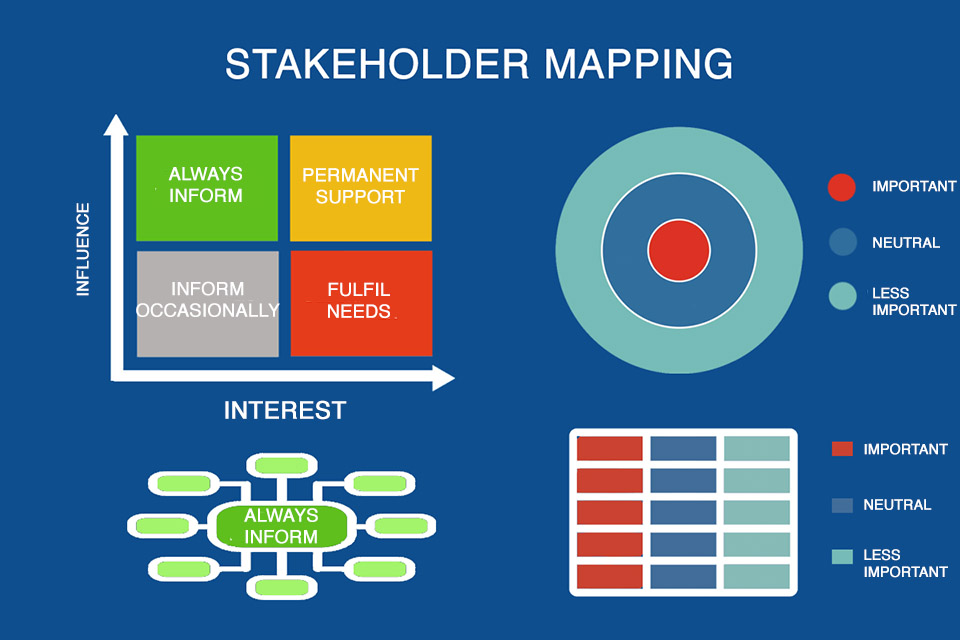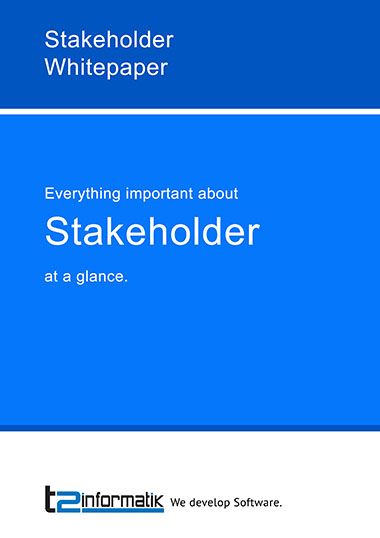What is Stakeholder Mapping?
Table of Contents: Definition – Forms of presentation – Categories – Process – Advantages and disadvantages – Tips – Notes
Stakeholder mapping – categorising stakeholders according to their importance
When working on projects and developing products, companies need to identify all relevant stakeholders and understand how their power and interest influence the success of the undertaking. Stakeholder mapping offers a solution here by creating a visual representation of stakeholders based on their importance. This method helps companies and project teams to develop targeted communication and management strategies to improve collaboration and recognise and manage potential conflicts at an early stage.
Stakeholder mapping is based on stakeholder analysis, which identifies the most important stakeholders for an undertaking, project or product development along with their interests, power, attitude and influence.
Alternative forms of presentation for stakeholder mapping
There are various forms of presentation for categorising stakeholders:
- The most common form is probably the stakeholder map – alternatively also known as the stakeholder matrix. It usually consists of 2 x 2 or 3 x 3 fields or 4 or 9 categories and categorises influence, interest or power.
- The stakeholder circle organises the categories in concentric circles, e.g. divided into internal and external, important and less important stakeholders. Grouping by function combined with different levels of influence with high, medium and low is also conceivable.
- The stakeholder mind map organises stakeholders around significance nodes so that stakeholders are linked by lines.
Stakeholders categorised according to their importance can also be recorded in a table. However, this form only corresponds to stakeholder mapping in the broadest sense.
Categories for mapping stakeholders
In addition to the forms of presentation, the categories can also vary. For example
- the influence or power of individual stakeholders from low to high,
- the attitude towards a defined undertaking from critical to positive,
- the opinion from fixed to open,
- influenceability from low to high or
- interest from low to high
can be used as categories.
The stakeholder mapping process
Stakeholder mapping is one aspect of stakeholder management. It comprises three central areas of responsibility:
- identification,
- analysis and
- communication.
Stakeholder identification is the first step in stakeholder management. It aims to determine all persons and organisations that are directly or indirectly affected by the company’s activities or have a concrete interest in these activities.
It is the basis for the stakeholder analysis, the second step in stakeholder management. The analysis identifies the most important stakeholders for an undertaking, project or development, their goals, motives and attitudes.
After identification and analysis, the stakeholders are categorised, prioritised and visualised. The result forms the basis for stakeholder communication. This refers to the regular dialogue between the company and its stakeholders.
Advantages and disadvantages of stakeholder mapping
Stakeholder mapping offers several advantages:
The visualisation is easy to create and easy to understand. It provides a good overview and basis for defining measures and communication strategies. It may help to identify potential conflicts or risks at an early stage. And it helps to make sensible use of resources when dealing with stakeholders.
However, there are also some disadvantages:
It is not always easy to maintain a good overview, especially when there are many stakeholders. In addition, categorisation is not always easy, especially as supporters or opponents of an undertaking are not always directly apparent. Furthermore, the categorisation findings can be influenced by subjective assessments. Last but not least, stakeholder mapping is not a one-off process; it requires regular updates and adjustments in order to remain current. These adjustments are often difficult to track, for example in an after action review.
Tips for stakeholder mapping
There are a few tips to help you categorise and visualise the people and organisations that have an interest in or are affected by an undertaking:
- Ideally, start identifying, analysing and categorising stakeholders at an early stage.
- Seek information from various sources in order to really identify all important stakeholders.
- Review the mapping regularly in order to be able to react to possible changes, e.g. through new communication strategies.
- Make sure that the set of important stakeholders does not become too large; if there is indeed a large set of interested people, then there is probably a subset within this set with even greater interest and influence on the project. Focus primarily on this subset without neglecting the others.
- The larger the number of identified stakeholders, the more important the form of presentation becomes. As clarity decreases with increasing numbers, many organisations opt for a tabular format in such cases.
Incidentally, there are differing opinions on how transparent the result of stakeholder mapping should be. How does a person who is attributed a lot of power but little interest react? How does someone react to the categorisation of a colleague who is considered more important for a project? On the other hand, transparency is also a means of building trust and communicating to people their importance for a project or development in order to involve them even more if necessary.
How can changes in mapping be tracked over time?
Notes:
If you like the article or would like to discuss it, please feel free to share it in your network. And if you have any comments, please do not hesitate to send us a message.
Here you can find a video how to build a key stakeholder map.
And here you can find additional information from our t2informatik Blog:




